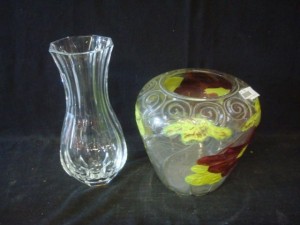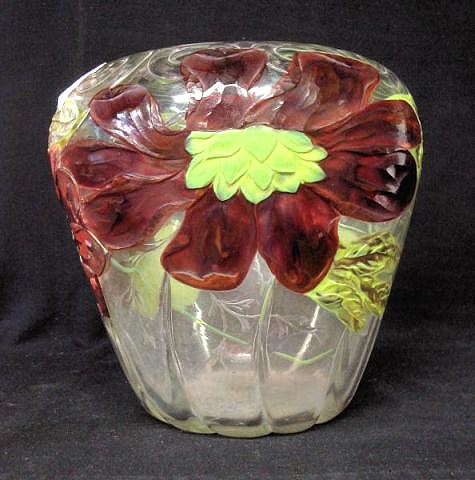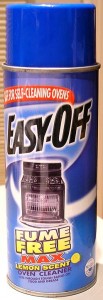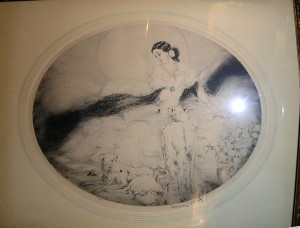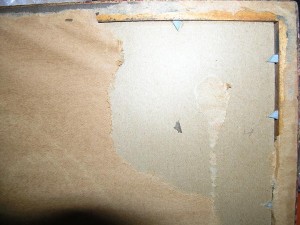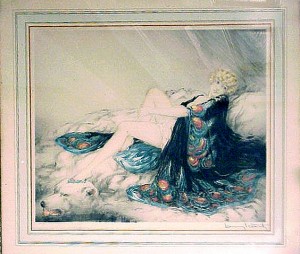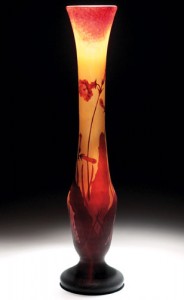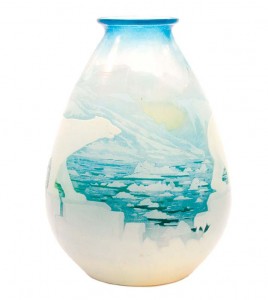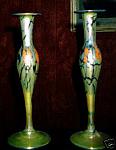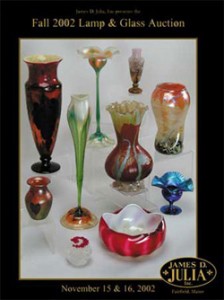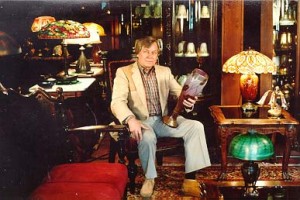
Bob Ogorek
Bob Ogorek of Plantation Galleries in Davison, Michigan, was a friend of mine. Bob died in 1999 and I miss him. He called me in early 1999 to tell me about a Tiffany chandelier that he had learned about in upstate New York. Since I was a lot closer than him, he asked if I could go look at it. I took a drive with my wife and met the couple selling the fixture in an upstate town. A blownout fixture of this type could easily damage, so I asked the owners to check the glass carefully in the sunlight to make sure it wasn’t cracked. They assured me that the condition was fine. I was concerned the whole time driving up because I figured the day would be wasted if the seller’s were wrong.
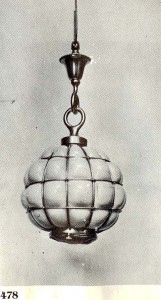
An original Tiffany Studios photograph from the bookTiffany at Auction, showing an almost identical fixture but without a long rod
We met in the parking lot of a supermarket to inspect the lamp. I held it up to the sunlight and inspected it with a fine-tooth comb. Everything was in order and I was delighted. I had never seen a chandelier like this in person, only in books. It was beautiful and very unusual, with a hinged turtleback tile door on the bottom to change the light bulb. I bought it for approximately $20,000. My arrangement with Bob was that we would buy it together and own it 50/50. It was a very difficult item to pack because the bronze rod to the ceiling could not be detached from the glass and it was 32½” long, overall. The sellers packed the blownout glass end carefully in a box and let the bronze rod stick straight up from the box, which was no problem as they had a van. I only had a station wagon, so I carefully put the chandelier on its side and drove home.
I called Peggy Gilges of Christie’s New York to consign the lamp for auction and met her on a sunny day at their warehouse in Long Island City. I removed the fixture from my station wagon and showed it to Peggy. She was very impressed and was oohing and ahing (is that how you spell ahing?). I held it up to the sunlight to show her the beautiful color when lit and suddenly saw a crack in the glass! I was horrified! How could that happen? I was so careful with handling and transporting it. I immediately took it back and went home crushed. $20,000 down the drain. How was I going to tell Bob?
I called him when I got back to explain that it had probably cracked from the pressure of the rod on the glass when it was riding on its side. Needless to say, he was more than a little disappointed. He asked me if I had insurance. “Yes”, I said. “Can’t you make a claim?” I didn’t know if I could, so I called my agent and asked him. He thought that I was probably covered under the accidental damage section of my policy. So I filed a claim and my insurance company agreed that yes, this was a legitimate claim. “How much are you claiming?” “$60,000.” “But why, you only paid $20,000?” “Because what I paid is irrelevant. I’m the expert and I say it’s worth $60,000.” The claims adjuster at my insurance company didn’t want to hear that, so he hired independent appraisers who said it wasn’t worth $60,000, but more like $25-30,000. So I was at an impasse with my insurance company when my broker intervened. He asked me if I would accept my cost back, with no deductible, and the damaged fixture. Sounded fair to me, so he talked to the adjuster, who also agreed. They paid me back my $20,000 cost and allowed me to keep the fixture. I was now the co-owner of a damaged fixture, but with a new cost of zero.
I then turned to Sotheby’s in New York City. I brought the fixture to them and met with Barbara Deisroth and Greg Kuharik in their offices. I showed them the fixture and they oohed and ahed (that can’t be how you spell ahed, maybe aahed?). “But Barbara, there’s a big crack here.” “Well, Phil, it doesn’t look too bad to me and it’s mostly hidden by the bronze cage. I think my clients will still want to buy it.” So I consigned the fixture to them for their 20th Century Decorative Works of Art sale to be held on June 10, 1999, with an estimate of $20-30,000.

Sotheby's New York, lot 370, June 10, 1999
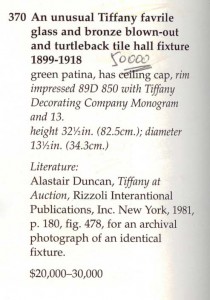
The Sotheby's catalog description for lot 370, with my hand-written final price
The auction day was fast approaching and I couldn’t wait. My reserve price was $20,000, which meant that if the bidding stopped before $20,000, Sotheby’s would return the item to me as unsold. The bidding started slowly, $12,000, $14,000, $16,000, $18,000, $20,000. Whew! Now at least it was sold. But the bidding kept going — $22,000, $24,000, $26,000, all the way to $50,000, which is $57,500, with the buyer’s premium included. How exciting! This was as good as going to the racetrack and seeing your horse win. Not only did I do well at the auction but I was totally vindicated! I had told my insurance company that the fixture was worth $60,000 in perfect condition and here it had just sold for $57,500 in damaged condition. Since our cost was zero, Bob and I split approximately $45,000 after paying Sotheby’s fees. I was one happy camper!
Knowledge is power. Sir Francis Bacon, Religious Meditations, Of Heresies, 1597.
Please send me your suggestions or questions about art glass, lamps, Louis Icart, shows, auctions, etc. If it’s interesting, I’ll answer your question in a future blog entry.
Call or write and let me know what you would like to buy, sell, or trade. philchasen@gmail or 516-922-2090. And please visit my website. chasenantiques.com
